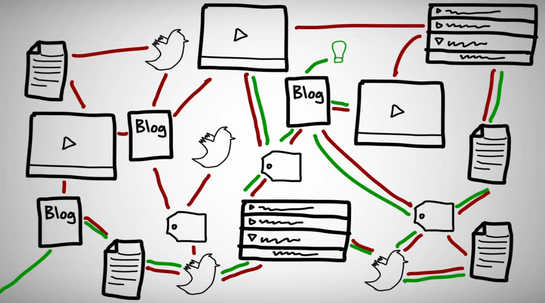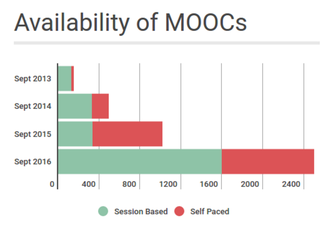Difference between revisions of "MOOC (Massive Open Online Courses)"
| Line 1: | Line 1: | ||
| − | + | A Massive Open Online Course (MOOC) is a freely accessible and highly participatory online course open to all. In addition to traditional course materials such as filmed lectures, readings, and problem sets, many MOOCs provide interactive user forums to support community interactions among students, professors, and teaching assistants (TAs).<ref name="Wikipedia">[https://en.wikipedia.org/wiki/Massive_open_online_course ], Wikipedia (MOOC).</ref> <br/> | |
| − | + | [[File:Moocpic1.PNG|framed|MOOCs users utilize many different channels to access information online.]] | |
| − | A Massive Open Online Course (MOOC) is a freely accessible and highly participatory online course open to all. In addition to traditional course materials such as filmed lectures, readings, and problem sets, many MOOCs provide interactive user forums to support community interactions among students, professors, and teaching assistants (TAs).<ref name="Wikipedia">[https://en.wikipedia.org/wiki/Massive_open_online_course ], Wikipedia (MOOC).</ref> | + | |
'''Five main ideas fundamental to MOOCs are:'''<ref name="TedTalk">[https://www.youtube.com/watch?v=rYwTA5RA9eU], TedTalk.</ref> | '''Five main ideas fundamental to MOOCs are:'''<ref name="TedTalk">[https://www.youtube.com/watch?v=rYwTA5RA9eU], TedTalk.</ref> | ||
| Line 18: | Line 17: | ||
* Peer Learning | * Peer Learning | ||
Through discussion forums and various instant messaging tools, students are encouraged to help each other understand the material better and challenge each other. | Through discussion forums and various instant messaging tools, students are encouraged to help each other understand the material better and challenge each other. | ||
| − | + | <br/> | |
| − | + | ||
'''Some of the most popular subjects to learn through MOOCs are:'''<ref name="moocsubjects">[http://mooc.org/]</ref> | '''Some of the most popular subjects to learn through MOOCs are:'''<ref name="moocsubjects">[http://mooc.org/]</ref> | ||
Revision as of 21:44, 21 February 2017
A Massive Open Online Course (MOOC) is a freely accessible and highly participatory online course open to all. In addition to traditional course materials such as filmed lectures, readings, and problem sets, many MOOCs provide interactive user forums to support community interactions among students, professors, and teaching assistants (TAs).[1]
Five main ideas fundamental to MOOCs are:[2]
- Interactive Learning
Students are encouraged to interact with the different lesson plans and formats the course offers and research has shown actually interacting with content is more effective for learning.
- Self-facing
All coursework is self-directed and only the student takes responsibility for their progress and how successful the course was in the end.
- Instant feedback
Students do not have to wait for professors to grade their assignments due to automatic online grading allowing the student to respond to the feedback right away and learn from mistakes.
- Gamification
Gamification techniques like creating online labs and rewarding students after reaching certain learning objectives encourages students to engage with the materials more.
- Peer Learning
Through discussion forums and various instant messaging tools, students are encouraged to help each other understand the material better and challenge each other.
Some of the most popular subjects to learn through MOOCs are:[3]
- Coding and Computer Science
- Data Science and Data Analytics
- Business and Management
- Languages
- Biology and Life Sciences
- Engineering
Contents
History
2007 – Before the term was even coined, the first MOOC created by Mike Feerick, CEO of Advance Learning Interactive Systems ONline, better known as ALISON.[4]
2008 – The term “MOOC" was coined during the course "Connectivism and Connective Knowledge" by Dave Cormier, from the University of Prince Edward Island. [5]
2011 – Stanford professors Peter Norvig and Sebastian Thrun created Introduction to Artificial Intelligence, a course that attracted 160,000 students from 190 countries.[6]
2012 – The New York Times named 2012 “The Year of the MOOC”, popularity of MOOCs rapidly increased at this time. [7]
2016 – Over 58 million registered users of at least one MOOC. [8]
Growth & Changes
Since 2008, more subjects have become available as MOOC’s and more MOOC’s have become available throughout different times of the year. Prior, MOOC’s were essentially college coursework uploaded online, with strict deadlines and a final exam. Now, MOOCs have adapted to its student’s needs by offering shorter courses with soft deadlines as long as all work is completed by the end of the session.
Business Model
All MOOCs courses are “open” in the sense that you are not paying to participate in the course and the materials are all open-sourced. This model does not generate revenue though so to solve this practical problem, some institutions make the materials close-sourced and students pay to get access to the material or to get credits from the institution. Some MOOCs providers make revenue from selling ad space on their site or selling related content. The industry has similar network economics to Amazon, eBay and Google in that “content producers go to where most consumers are, and consumers go to where the most content is.”[9].
Providers
Top providers of MOOCs include the following:
- Coursera - 2,368 courses
Coursera is an education platform that partners with top universities and organizations worldwide, to offer courses online for anyone to take, for free.
- edX – 1,338 courses
Through our institutional partners, the xConsortium, along with other leading global members, we present the best of higher education online, offering opportunity to anyone who wants to achieve, thrive, and grow.
- Udacity – 173 courses
We believe that higher education is a basic human right, and we seek to empower our students to advance their education and careers.
- FutureLearn – 504 courses
We believe learning should be an enjoyable, social experience, so our courses offer the opportunity to discuss what you’re learning with others as you go, helping you make fresh discoveries and form new ideas.
- NovoEd – 76 courses
NovoEd is committed to being on the cutting edge of innovation in pedagogy, and our platform is the only one designed to connect students to each other and to their instructors around content at scale.
Benefits
There are many advantages to Massive Open Online Courses. They are freely accessible so the cost is much cheaper than tuition at a university, but they still meet high academic standards through internal auditing. They are also self-directed so students can go at their own pace. MOOC’s also provide an opportunity for educators to reach a much larger and diverse audience than they could in a physical space. Another key is that there are no requirements to join, so courses are available to all. Overall MOOCs are a more affordable and flexible way to learn a new skill or educate oneself further on a subject. They are a way to connect and collaborate while developing digital skills. [10]
Challenges & Criticisms
• Research[11] has shown blended learning (a combination of face-to-face and online learning) is most effective, instead of just strictly online. • Policies for data sharing are difficult to create and uphold. • Student anonymity can pose a problem for research on the effectiveness of MOOC’s courses.
Future of MOOCs
With the world being more connected and having higher enrollment rates than ever, MOOC’s are expected to continue growing and disrupt traditional higher education models.

